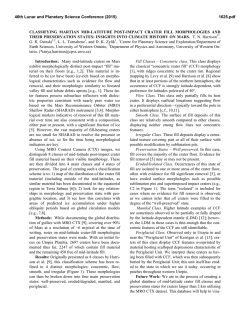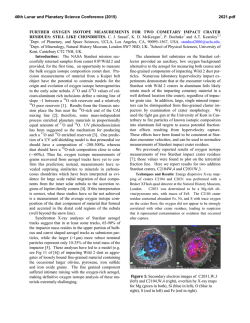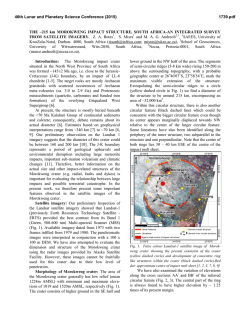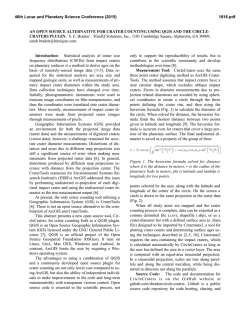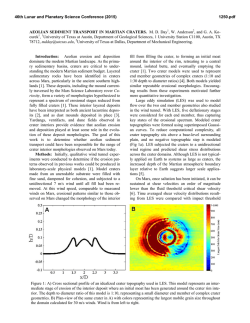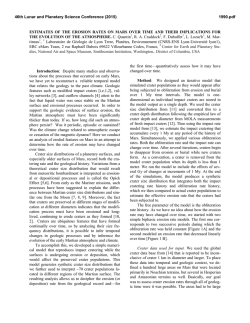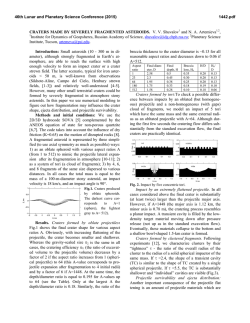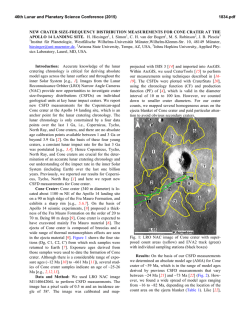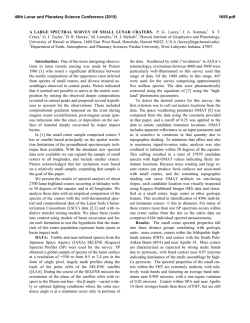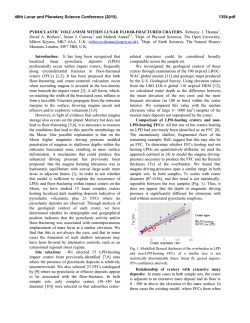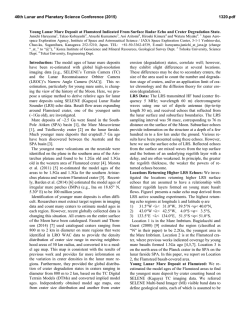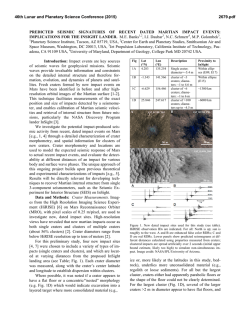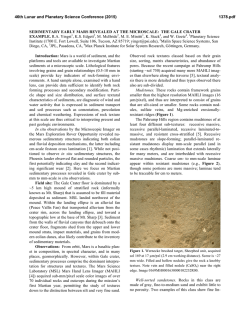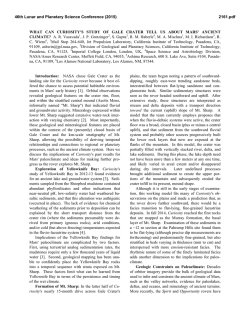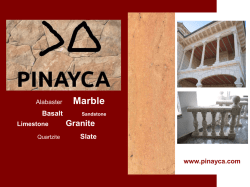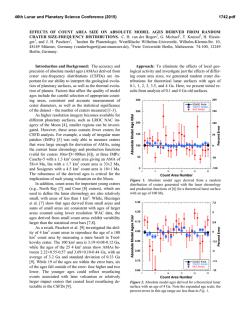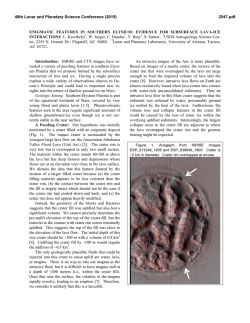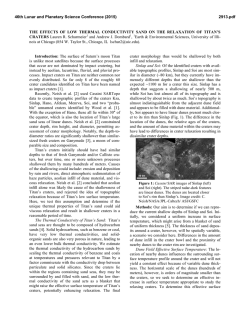
EXPERIMENTAL CRATERING IN CARRARA MARBLE: LATEST
46th Lunar and Planetary Science Conference (2015) 2447.pdf EXPERIMENTAL CRATERING IN CARRARA MARBLE: LATEST RESULTS FROM THE MEMIN RESEARCH UNIT. M. H. Poelchau1, C. Michalski2, A. Deutsch3, K. Thoma2, F. Schäfer2, T. Kenkmann1. 1Institut für Geo- und Umweltnaturwissenschaften, Universität Freiburg, D79104 Freiburg, Germany, 2Fraunhofer ErnstMach-Institut (EMI), Freiburg, 3Institut f. Planetologie, WWU Münster. ([email protected]). strength and porosity, as an increase in either value reduces crater size [2,3] For marble targets, compressive strengths of 60 MPa are ~5 times lower than those of the quartzite targets (292 MPa). Therefore, crater volumes were expected to be much larger, as both targets have similar, negligible porosities of ~1%. Fig. 1: Experimental impact crater formed in a Carrara marble target. The crater were formed by a 4 mm aluminum projectile at ~7 km/s. Target is 25x25x25 cm. 10000 Dry sandstone Tuff Quartzite 1000 Crater volume [cm³] Introduction: The increase of remote sensing missions to all types of bodies in the solar system is accompanied by an increase in resolution of remote sensing images. Small impact craters on these bodies can be observed at increasingly high detail. At this size, target material properties play a dominant role in the formation and final shape of these craters. The study of the effects of target material properties can give insights into the processes that occur in strengthdominated cratering, as well as contribute to an improved understanding of modeling and scaling these craters in both a terrestrial and planetary context. The MEMIN research unit has been actively pursuing these goals. Following experimental campaigns that focused on silicate targets and porous targets [1-3], we have expanded the range of target materials to calcitebearing marble. Cratering Experiments: Five impact experiments were performed at the two-stage light-gas gun facilities of the Fraunhofer Ernst-Mach Institute [4] on four marble targets. Three types of spherical projectiles were used; a 2.5 mm Campo del Cielo iron meteorite, two 4 mm Aluminum 55X G28J2 spheres, and a 6 mm basalt sphere. Impact velocities were between 5 and 7 km/s (Table 1). Targets were 25 cm edge length cubes. As with previous MEMIN experiments [4], the impacts were recorded with high-speed cameras; ultrasound sensors were attached to the targets and ejecta particle catchers were set up opposite of the target surface. Italian Carrara marble (Fig. 1) was chosen as a target material to expand the range of geological materials from silicate targets previously used in MEMIN (sandstone, quartzite and tuff) to CaCO3. Its uniaxial compressive strength (UCS) was measured at 60 ± 8 MPa. Its tensile strength is 7.3 ± 2.6 MPa, and its Young’s modulus is 17.0 ± 3.4 GPa. The marble’s density is 2.7 g/cm³ and its porosity is estimated at <1%. Results: Crater volumes were generated from 3D laser scans of the impacted Carrara marble target surfaces. The volumes are plotted against the impact energy in Fig. 2. Volumes show a typical increase with impact energy. Somewhat surprising is the fact that the marble crater volumes plot together with crater volumes of experiments performed in tuff, quartzite and sandstone targets. For these three silicate targets, the resulting similar volumes were suggested to be an effect on an inverse relationship between the target’s Carrara 100 Final crater volumes 10 1 100 1000 10000 100000 Impact energy [J] Fig. 2: Experimental crater volumes plotted against impact energy. 46th Lunar and Planetary Science Conference (2015) Strength Scaling: π-group scaling is a useful tool for comparing impacts in targets with different strengths. The benefit of using dimensionless π-groups is that the effects of target strength and density on crater size can be factored in. Additionally, impact energy does not yield unambiguous results for crater sizes; impactor mass and velocity must be considered separately. In Fig. 3, the cratering efficiency πV = V ρt / m, where V is the crater volume, ρt is the target density, and m is the projectile mass, is plotted against the strength size parameter π3 = Y / ρt vi², where vi is the impact velocity and Y is the target strength. UCS values were used for Y. To correct for the varying density contrast between target and projectile, a π4 term is used, where π4 is the ratio of projectile to target density. For the scaling exponent ν a value of 0.4 is used (e.g. [5]). πV * π41-3ν 4000 πV * π4-0.2 = 0.86±0.30 π3-0.96±0.05 Sandstone Quartzite Tuff Carrara marble 400 40 1E-04 1E-03 1E-02 π 3 = Y / ρ t v i² Fig. 3: Strength scaling of experimental crater volumes. Experiments using a range of target materials are shown. Craters in non-porous quartzite targets lie near the trend for basalt craters (dashed line, data from [6]), while craters in higher-porosity targets lie beneath the basalt trend and have lower cratering efficiencies. Surprisingly, although Carrara marble has no porosity, its scaled volumes plot together with porous sandstones. This implies that either uniaxial compressive strength strongly misrepresents the dynamic strength behavior of these materials, or that a further process, perhaps CaCO3 dissociation, impedes the shock wave. A trend of impact craters in basalt targets published in [6] is shown in Fig. 3, and non-porous quartzites lie close to this trend, while lower-strength sandstone and tuff targets with higher porosities lie further to the left of this curve and thus have much lower cratering efficiencies than expected for their (non-porous) π3 values. Surprisingly, craters in Carrara marble also plot near 2447.pdf the sandstone craters, in spite of their lack of porosity. Marble crater volumes are thus too small when compared to a theoretical non-porous silicate target of the same strength. Why are marble craters “too small”? The reduced crater volumes compared to non-porous silicate targets could imply that quasi-static uniaxial compressive strength is an inadequate proxy for the dynamic strength behavior of these materials. Studies on dynamic strength [7,8] show a strength increase above a certain strain rate. This threshold strain rate is dependent on a number of material properties, including microflaw size and distribution, as well as the speed of sound of the material [8]. If we assume that marble craters should plot along the basalt trend, the difference in the strength value Y can be calculated according to [3]. In this case, the strength value should be ~230 MPa instead of 60 MPa, or roughly 4x larger. It is possible that Carrara marble has a much lower threshold strain rate for dynamic strength behavior, although literature values for other marbles do not show any major difference to silicates [7]. Dynamic strength data of the Carrara marble and quartzite would certainly be help to clarify this, and will be measured in the near future. (Spallation may also play a significant role for the size of the final crater, as shown in [3]. For this, an estimation of the transient crater volume is required. Regrettably, due to difficulties during the experiments, data necessary for the transient crater estimation could not be gathered.) Alternatively, a further process, perhaps CaCO3 dissociation or devolatization, could impede the shock wave. Devolatization to CaO + CO2 occurs above 50 GPa [9]. Peak shock pressures for the experiments lie at 50-90 GPa, as calculated by the planar impact approximation. While devolatization is thus possible, these pressures are confined to a small region at the point of impact, and the contribution of this process to crater size reduction may not be a dominant factor. Acknowledgements: The MEMIN program is supported by the DFG (Research Unit FOR-887; KE732/16-2, TH 805/4-2). References: [1] Kenkmann T. et al. (2011) M&PS, 46, 890–902. [2] Poelchau M. H. et al. (2013) M&PS, 48, 8-22. [3] Poelchau M. H. et al. (2014) Icarus, 242, 211–224. [4] Lexow B. et al. (2013) M&PS, 48, 3-7. [5] Holsapple K. & Housen K. (2007) Icarus, 187, 345–356. [6] Moore H. J. et al. (1963) Proc. Hyperv. Impact Sym. 6th, 5, 367-400. [7] Zhang, Q. B., & Zhao, J. (2013) Rock Mech. & Rock Eng., 1-68. [8] Kimberley, J., et al. (2013) Acta Mater., 61, 35093521. [9] Badjukov, D. D. et al. (1995) LPSC XXVI, 63–64.
© Copyright 2025

